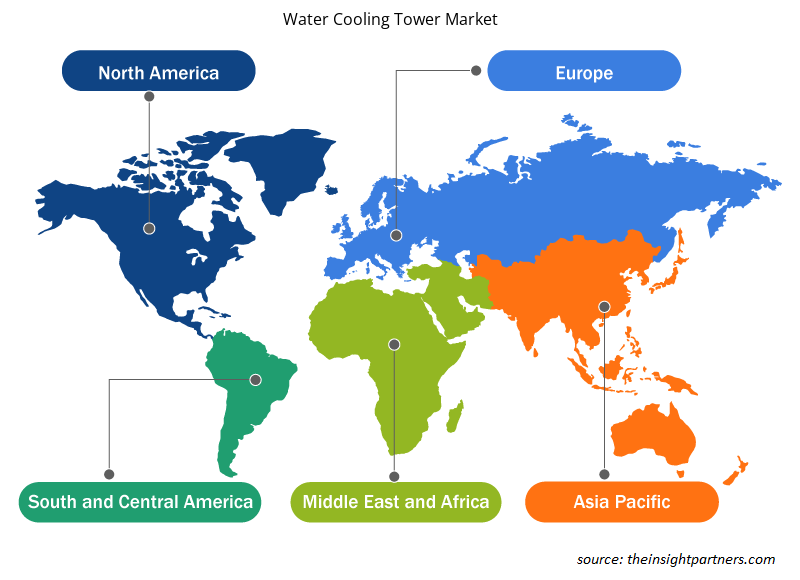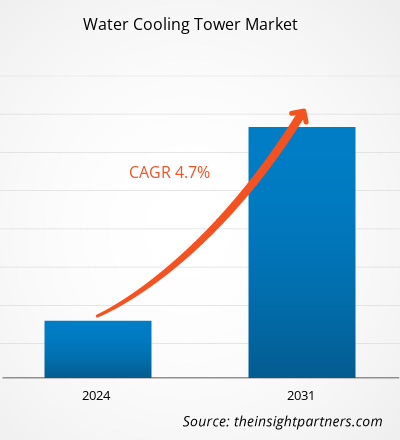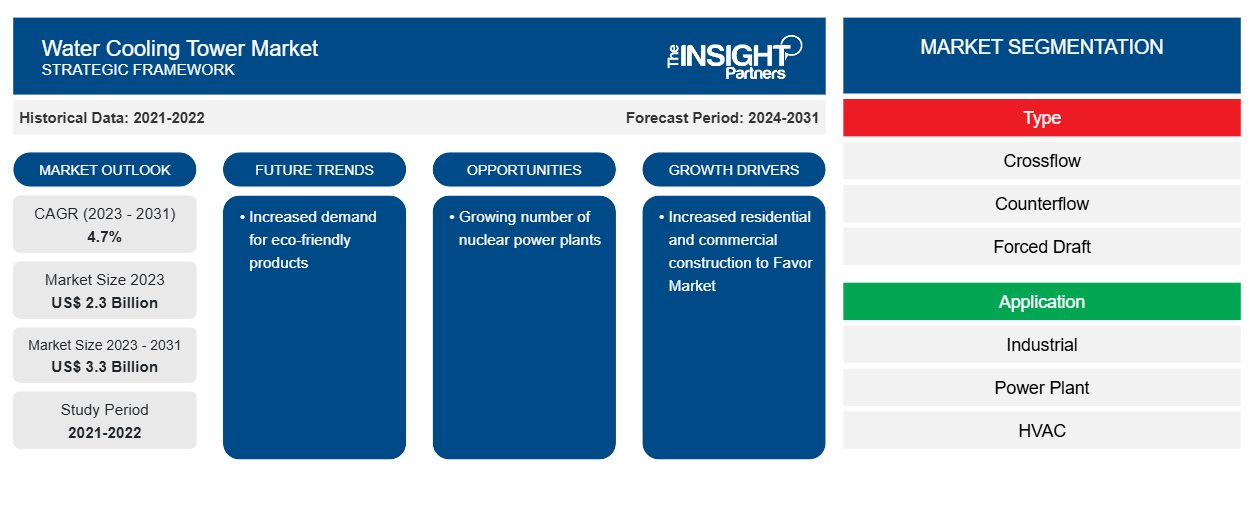Se proyecta que el tamaño del mercado de torres de enfriamiento de agua alcance los 3300 millones de dólares estadounidenses en 2031, frente a los 2300 millones de dólares estadounidenses en 2023. Se espera que el mercado registre una CAGR del 4,7 % durante el período 2023-2031. Con las crecientes preocupaciones por la sostenibilidad y la reducción de la huella de carbono, ha aumentado la demanda de productos ecológicos para la refrigeración de torres de agua. Por lo tanto, es probable que una mayor sostenibilidad siga siendo una tendencia clave en el mercado.
Análisis del mercado de torres de enfriamiento de agua
La demanda de torres de refrigeración por agua ha aumentado en el sector energético. A medida que crece la demanda de energía, el gasto en la construcción de plantas de energía y, por lo tanto, el número total de plantas de energía ha aumentado en los últimos años. Por ejemplo, según los datos publicados por el gobierno de EE. UU., el país se está centrando en construir un 55% más de plantas de energía en 2024 en comparación con 2023. Este gasto en construcción en el sector energético está impulsando la demanda del mercado de torres de refrigeración por agua.
Descripción general del mercado de torres de enfriamiento de agua
En 2023, América del Norte representó una participación de mercado notable del mercado mundial de torres de enfriamiento de agua. Países como Estados Unidos y Canadá lideran el mercado de torres de enfriamiento de agua de América del Norte. Uno de los factores que impulsa el mercado es el fuerte crecimiento industrial. Los centros de datos requieren un sistema de enfriamiento fuerte para mantener la eficiencia operativa. Por lo tanto, muchos de los centros de datos están instalados con torres de enfriamiento para mantener la temperatura. Las torres de enfriamiento en los centros de datos utilizan aire y agua para transferir el calor de los centros de datos. Estos sistemas de enfriamiento tienen una mayor eficiencia que los métodos tradicionales de enfriamiento por aire , menores costos operativos y flexibilidad. Según los datos de Cloudscene , Estados Unidos tiene aproximadamente 5400 centros de datos en Estados Unidos. Por lo tanto, debido a la presencia de una gran cantidad de centros de datos, la demanda de torres de enfriamiento de agua ha aumentado en los últimos años.
Personalice este informe según sus necesidades
Obtendrá personalización en cualquier informe, sin cargo, incluidas partes de este informe o análisis a nivel de país, paquete de datos de Excel, así como también grandes ofertas y descuentos para empresas emergentes y universidades.
-
Obtenga las principales tendencias clave del mercado de este informe.Esta muestra GRATUITA incluirá análisis de datos, desde tendencias del mercado hasta estimaciones y pronósticos.
Factores impulsores y oportunidades del mercado de torres de enfriamiento de agua
Aumento de la construcción residencial y comercial para favorecer el mercado
Las construcciones comerciales y residenciales están creciendo rápidamente debido a la importante urbanización e industrialización. Aproximadamente más del 93% del total de edificios son construcciones residenciales y comerciales; además, aproximadamente el 85% de los metros cuadrados de los edificios están dedicados a la construcción residencial y comercial. Con una penetración tan alta de la construcción residencial y comercial, la demanda de sistemas de calefacción, ventilación y aire acondicionado ha aumentado, lo que en última instancia impulsa el mercado de torres de enfriamiento de agua.
Creciente número de centrales nucleares
A medida que aumenta la demanda de energía, también lo hace la de plantas de energía nuclear. Además, debido a la mayor conciencia sobre las emisiones de carbono, se ha prestado más atención a las plantas de energía nuclear, ya que son más eficientes y efectivas. Según los datos publicados por el Instituto de Energía Nuclear, en los EE. UU. se evitan aproximadamente 471 millones de toneladas métricas de carbono mediante el uso de plantas de energía nuclear. Además, a día de hoy, las fuentes de energía nuclear contribuyen al 10% de la electricidad mundial. Por lo tanto, los gobiernos de todo el mundo están aumentando la contribución de las plantas de energía nuclear mediante la construcción de más plantas de energía. Por ejemplo, según los datos publicados por la Asociación Nuclear Mundial, hay 60 plantas de energía nuclear en construcción . Por lo tanto, se proyecta que el aumento de la demanda de plantas de energía nuclear generará importantes oportunidades de ingresos en los próximos años.
Informe de mercado de torres de enfriamiento de agua Análisis de segmentación
Los segmentos clave que contribuyeron a la derivación del análisis del mercado de torres de enfriamiento de agua son el tipo y la aplicación.
- Según el tipo, el mercado de torres de enfriamiento de agua se divide en flujo cruzado, contraflujo, tiro forzado, tiro inducido y otros. El segmento de flujo cruzado tuvo una mayor participación de mercado en 2023.
- Por aplicación, el mercado se segmenta en industrial, planta de energía y HVAC. El segmento industrial tuvo una participación notable en el mercado en 2023.
Análisis de la cuota de mercado de las torres de refrigeración por agua por geografía
El alcance geográfico del informe de mercado de la torre de enfriamiento de agua se divide principalmente en cinco regiones: América del Norte, Asia Pacífico, Europa, Medio Oriente y África, y América del Sur y Central.
La región de Asia Pacífico tiene la cuota de mercado dominante en el mercado mundial de torres de refrigeración por agua. Países como China, India, Indonesia y Filipinas están creciendo notablemente. Este crecimiento está generando una mayor demanda de energía, ya que el sector industrial está creciendo rápidamente. Además, debido a la urbanización, ha aumentado la demanda de los sectores residencial y comercial. Con este crecimiento en los sectores de la construcción, industrial y energético, ha aumentado la demanda de sistemas de refrigeración rentables, lo que en última instancia ha impulsado el mercado de torres de refrigeración por agua.
Perspectivas regionales del mercado de torres de enfriamiento de agua
Los analistas de Insight Partners explicaron en detalle las tendencias y los factores regionales que influyen en el mercado de torres de enfriamiento de agua durante el período de pronóstico. Esta sección también analiza los segmentos y la geografía del mercado de torres de enfriamiento de agua en América del Norte, Europa, Asia Pacífico, Medio Oriente y África, y América del Sur y Central.

- Obtenga datos regionales específicos para el mercado de torres de enfriamiento de agua
Alcance del informe de mercado de torres de enfriamiento de agua
| Atributo del informe | Detalles |
|---|---|
| Tamaño del mercado en 2023 | 2.300 millones de dólares estadounidenses |
| Tamaño del mercado en 2031 | US$ 3.3 mil millones |
| CAGR global (2023 - 2031) | 4,7% |
| Datos históricos | 2021-2022 |
| Período de pronóstico | 2024-2031 |
| Segmentos cubiertos |
Por tipo
|
| Regiones y países cubiertos |
América del norte
|
| Líderes del mercado y perfiles de empresas clave |
|
Densidad de actores del mercado: comprensión de su impacto en la dinámica empresarial
El mercado de torres de enfriamiento de agua está creciendo rápidamente, impulsado por la creciente demanda de los usuarios finales debido a factores como la evolución de las preferencias de los consumidores, los avances tecnológicos y una mayor conciencia de los beneficios del producto. A medida que aumenta la demanda, las empresas amplían sus ofertas, innovan para satisfacer las necesidades de los consumidores y aprovechan las tendencias emergentes, lo que impulsa aún más el crecimiento del mercado.
La densidad de actores del mercado se refiere a la distribución de las empresas o firmas que operan dentro de un mercado o industria en particular. Indica cuántos competidores (actores del mercado) están presentes en un espacio de mercado determinado en relación con su tamaño o valor total de mercado.
Las principales empresas que operan en el mercado de torres de enfriamiento de agua son:
- Empresas Babcock y Wilcox
- Cª
- Compañía de bobinas de aire de Baltimore
- Torres de enfriamiento de campana
- Torres de enfriamiento Delta
- Cª
Descargo de responsabilidad : Las empresas enumeradas anteriormente no están clasificadas en ningún orden particular.

- Obtenga una descripción general de los principales actores clave del mercado de torres de enfriamiento de agua
Noticias y desarrollos recientes del mercado de torres de enfriamiento de agua
El mercado de torres de enfriamiento de agua se evalúa mediante la recopilación de datos cualitativos y cuantitativos posteriores a la investigación primaria y secundaria, que incluye publicaciones corporativas importantes, datos de asociaciones y bases de datos. A continuación, se enumeran algunos de los desarrollos en el mercado de torres de enfriamiento de agua:
- Baltimore Aircoil Company (BAC) anuncia el lanzamiento de su nuevo enfriador adiabático TrilliumSeries. Este enfriador adiabático es ideal para aplicaciones que exigen una combinación de eficiencia energética y uso limitado de agua. El diseño innovador de BAC maximiza la eficiencia tanto del agua como de la energía, lo que en última instancia minimiza los costos. Además, el enfriador TrilliumSeries está diseñado para simplificar la instalación y el mantenimiento continuo. (Fuente: Baltimore Aircoil Company, comunicado de prensa, febrero de 2022)
- Tower Tech, el fabricante líder de torres de refrigeración, se enorgullece de anunciar su línea de torres de refrigeración con tecnología resistente a la corrosión de polímero reforzado con fibra (FRP) StormStrong. Las torres de refrigeración StormStrong son capaces de soportar vientos huracanados, terremotos y tensiones relacionadas con el clima con daños mínimos o nulos. (Fuente: Tower Tech, comunicado de prensa, septiembre de 2022)
Informe de mercado sobre torres de enfriamiento de agua: cobertura y resultados
El informe “Tamaño y pronóstico del mercado de torres de enfriamiento de agua (2021-2031)” proporciona un análisis detallado del mercado que cubre las siguientes áreas:
- Tamaño del mercado de torres de enfriamiento de agua y pronóstico a nivel global, regional y nacional para todos los segmentos clave del mercado cubiertos bajo el alcance
- Tendencias del mercado de torres de enfriamiento de agua, así como dinámicas del mercado, como impulsores, restricciones y oportunidades clave
- Análisis PEST y FODA detallados
- Análisis del mercado de torres de enfriamiento de agua que cubre las tendencias clave del mercado, el marco global y regional, los principales actores, las regulaciones y los desarrollos recientes del mercado
- Panorama de la industria y análisis de la competencia que abarca la concentración del mercado, análisis de mapas de calor, actores destacados y desarrollos recientes en el mercado de torres de enfriamiento de agua
- Perfiles detallados de empresas
- Análisis histórico (2 años), año base, pronóstico (7 años) con CAGR
- Análisis PEST y FODA
- Tamaño del mercado, valor/volumen: global, regional y nacional
- Industria y panorama competitivo
- Conjunto de datos de Excel
Informes recientes
Informes relacionados
Testimonios
Razón para comprar
- Toma de decisiones informada
- Comprensión de la dinámica del mercado
- Análisis competitivo
- Información sobre clientes
- Pronósticos del mercado
- Mitigación de riesgos
- Planificación estratégica
- Justificación de la inversión
- Identificación de mercados emergentes
- Mejora de las estrategias de marketing
- Impulso de la eficiencia operativa
- Alineación con las tendencias regulatorias























 Obtenga una muestra gratuita para - Mercado de torres de enfriamiento de agua
Obtenga una muestra gratuita para - Mercado de torres de enfriamiento de agua